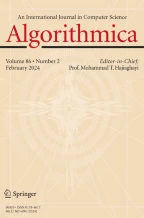Abstract
We study the (1+\(\lambda \)) EA, a classical population-based evolutionary algorithm, with mutation probability c / n, where \(c>0\) and \(\lambda \) are constant, on the benchmark function OneMax, which counts the number of 1-bits in a bitstring. We improve a well-established result that allows to determine the first hitting time from the expected progress (drift) of a stochastic process, known as the variable drift theorem. Using our improved result, we show that upper and lower bounds on the expected runtime of the (1+\(\lambda \)) EA obtained from variable drift theorems are at most apart by a small lower order term if the exact drift is known. This reduces the analysis of expected optimization time to finding an exact expression for the drift. We then give an exact closed-form expression for the drift and develop a method to approximate it very efficiently, enabling us to determine approximate optimal mutation rates for the (1+\(\lambda \)) EA for various parameter settings of c and \(\lambda \) and also for moderate sizes of n. This makes the need for potentially lengthy and costly experiments in order to optimize c for fixed n and \(\lambda \) for the optimization of OneMax unnecessary. Interestingly, even for moderate n and not too small \(\lambda \) it turns out that mutation rates up to 10% larger than the asymptotically optimal rate 1 / n minimize the expected runtime. However, in absolute terms the expected runtime does not change by much when replacing 1 / n with the optimal mutation rate.
Similar content being viewed by others
References
Auger, A., Doerr, B. (ed.): Theory of Randomized Search Heuristics: Foundations and Recent Developments. World Scientific Publishing, (2011)
Abramowitz, M., Stegun, I.A.: Handbook of Mathematical Functions with Formulas, Graphs, and Mathematical Tables. National Bureau of Standards, Gaithersburg (1964)
Böttcher, S., Doerr, B., Neumann, F.: Optimal fixed and adaptive mutation rates for the leadingones problem. In Proceedings of Parallel Problem Solving from Nature (PPSN 2010), vol. 6238, pp. 1–10. Springer (2010)
Badkobeh, G., Lehre, P.K., Sudholt, D.: Unbiased black-box complexity of parallel search. In: Parallel Problem Solving from Nature—PPSN XIII—13th International Conference, Ljubljana, Slovenia, September 13–17, 2014. Proceedings, pp. 892–901. (2014)
Chicano, F., Sutton, A.M., Whitley, L.D., Alba, E.: Fitness probability distribution of bit-flip mutation. Evolut. Comput. 23(2), 217–248 (2015)
Doerr, B., Doerr, C., Yang, J .: Optimal parameter choices via precise black-box analysis. In: Proceedings of the 2016 on Genetic and Evolutionary Computation Conference, Denver, CO, USA, July 20–24, 2016, pp. 1123–1130. (2016)
Doerr, B., Fouz, M., Witt, C.: Sharp bounds by probability-generating functions and variable drift. In: Procedings of the Genetic and Evolutionary Computation Conference (GECCO 2011), pp. 2083–2090. ACM Press (2011)
Doerr, B., Goldberg, L.A.: Adaptive drift analysis. Algorithmica 65(1), 224–250 (2013)
Droste, S., Jansen, T., Wegener, I.: On the analysis of the (1+1) evolutionary algorithm. Theor. Comput. Sci. 276, 51–81 (2002)
Doerr, B., Künnemann, M.: Royal road functions and the (1+\(\lambda \)) evolutionary algorithm: almost no speed-up from larger offspring populations. In: Proceedings of the IEEE Congress on Evolutionary Computation (CEC 2013), pp. 424–431. IEEE Press, (2013)
Doerr, B., Künnemann, M.: Optimizing linear functions with the (1+\(\lambda \)) evolutionary algorithm - different asymptotic runtimes for different instances. Theor. Comput. Sci. 561, 3–23 (2015)
Gießen, C., Witt, C.: Population size versus mutation strength for the (1+\(\lambda \)) EA on OneMax. In: Proceedings of GECCO ’15, pp. 1439–1446. ACM Press, (2015)
Gießen, C., Witt, C.: Optimal mutation rates for the (1+\(\lambda \)) EA on onemax. In: Proceedings of the 2016 on Genetic and Evolutionary Computation Conference, Denver, CO, USA, July 20–24, 2016, pp. 1147–1154, (2016)
Hwang, H.-K., Panholzer, A., Rolin, N., Tsai, T.-H., Chen, W.-M.: Probabilistic analysis of the (1+1)-evolutionary algorithm. Evol. Comput. (2017). doi:10.1162/EVCO_a_00212
Jansen, T.: Analyzing Evolutionary Algorithms—The Computer Science Perspective. Natural Computing Series. Springer, Berlin (2013)
Jansen, T., De Jong, K.A., Wegener, I.: On the choice of the offspring population size in evolutionary algorithms. Evolut. Comput. 13(4), 413–440 (2005)
Johannsen, D.: Random combinatorial structures and randomized search heuristics. Ph.D. thesis, Universität des Saarlandes, Germany, (2010)
Lehre, P.K., Witt, C.: Concentrated hitting times of randomized search heuristics with variable drift. In: Proceedings of ISAAC ’14, Volume 8889 of Lecture Notes in Computer Science, pp. 686–697. Springer, 2014. Full technical report at http://arxiv.org/abs/1307.2559
Mitavskiy, B., Rowe, J.E., Cannings, C.: Theoretical analysis of local search strategies to optimize network communication subject to preserving the total number of links. Int. J. Intell. Comput. Cybern. 2(2), 243–284 (2009)
Neumann, F., Witt, C.: Bioinspired Computation in Combinatorial Optimization—Algorithms and Their Computational Complexity. Natural Computing Series. Springer, Berlin (2010)
Jonathan, E.: Rowe and Dirk Sudholt. The choice of the offspring population size in the (1, \(\lambda \)) evolutionary algorithm. Theoretical Computer Science, 545:20–38, 2014. Preliminary version in Proceedings of GECCO 2012
Skellam, J.G.: The frequency distribution of the difference between two poisson variates belonging to different populations. J. R. Stat. Soc. 109(3), 296–296 (1946)
Teerapabolarn, K.: A bound on the poisson-binomial relative error. Stat. Methodol. 4(4), 407–415 (2007)
Witt, C.: Tight bounds on the optimization time of a randomized search heuristic on linear functions. Comb Prob. Comput. 22(2):294–318, 2013. Preliminary version in Proceedings of STACS ’12
Acknowledgements
This work was supported by the Danish Council for Independent Research (DFF), Grant No. 4002-00542.
Author information
Authors and Affiliations
Corresponding author
Additional information
A preliminary version of this paper was published at GECCO 2016 [13].
Rights and permissions
About this article
Cite this article
Gießen, C., Witt, C. Optimal Mutation Rates for the (1+\(\lambda \)) EA on OneMax Through Asymptotically Tight Drift Analysis. Algorithmica 80, 1710–1731 (2018). https://doi.org/10.1007/s00453-017-0360-y
Received:
Accepted:
Published:
Issue Date:
DOI: https://doi.org/10.1007/s00453-017-0360-y
